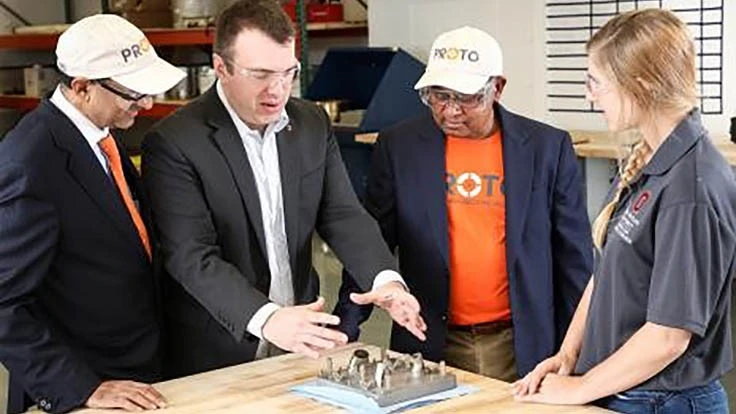
CDME’s Ed Herderick details the center’s first nickel alloy print from the Concept Laser metal printer to Proto Precisions’ John Johnson (left), Sugu Suguness, and engineering student Jordan Potts.
Thanks to a collaboration with Proto Precision Manufacturing Solutions and GE Additive, The Ohio State University’s Center for Design and Manufacturing Excellence (CDME) has added state-of-the-art industrial metal printers to their additive manufacturing laboratory.
Led by engineering alumnus Sugu Suguness, Proto Precision has placed two recently purchased GE Additive machines at CDME, located on Ohio State’s west campus in Columbus. The industrial-grade Arcam Q10+ and Concept Laser metal printers are capable of printing nickel alloys, titanium, and steel using laser and electron beams, respectively, and are the most recent additions to CDME’s growing additive manufacturing capabilities. Two additional GE Additive machines are operating at Proto Precision’s facility in nearby Hilliard, Ohio.
“Partnering with GE Additive and CDME allows us to come together to accelerate the growth in the central Ohio additive ecosystem, empowering us to meet the needs of a growing customer base,” said Suguness. “Industry demands are trending towards titanium implants for medical, and lightweight metal parts and quicker production for automobile and aerospace.”
The manufacturing port of entry into Ohio State, CDME provides product design, technology commercialization and manufacturing services to its industry partners. Student experiential learning also is a key tenant of CDME’s mission.
“At CDME we bring together industry with our world-leading research enterprise,” remarked College of Engineering Dean David B. Williams. “Uniting an innovative small business like Proto Precision with GE Additive and Ohio State faculty, staff and students is a perfect example of our work to address the biggest challenges in manufacturing.”
The new metal printers are part of GE Additive’s latest product portfolio. The Arcam Q10+ prints titanium, which can be used for medical implants and aerospace parts. The Concept Laser prints titanium and nickel alloy parts often used in the automotive and aerospace industries. CDME also recently added an ExOne printer, which uses a binder jetting interface with metal powder. The ability to print using laser, electron beam, and binder jetting within one university lab is unique according to Ed Herderick, director of additive manufacturing at CDME.
“Now Ohio State faculty have another valuable option in translating their research to prototype and testing modes,” he explained. “And small businesses and manufacturers can quickly integrate high-end metal printing capability into their operation folds by partnering with us.”
The Wohlers Report 2018 estimates 1,768 metal additive manufacturing systems were sold in 2017, compared to 983 systems in 2016, an increase of nearly 80%. Globally, more manufacturers are appreciating of the benefits of producing metal parts by additive manufacturing.
CDME’s additive manufacturing laboratory now includes:
- Concept Laser (nickel alloys, steels, aluminum, cobalt chrome)
- Arcam Q10+ (titanium alloys)
- ExOne (steels, magnesium alloys, nickel alloys)
- ProJet 660Pro (ceramics, including alumina, YSZ)
- ProJet 3500 HD Max (ABS-like cured photopolymers)
- FormLab Form 2 (resin)
- Mcor IRIS HD (paper)
- Afinia H800 (ABS, PLA, PC-ABS)
- Afinia H400 (ABS, PLA, PC-ABS)
- Stratasys (ABS, PLA, ACA, PC-ABS)
- Mark Forged 2 (nylon, nylon carbon fiber)
Latest from Aerospace Manufacturing and Design
- DEMGY Group acquires Tool-Gauge
- OES’ dual-axis yaw pitch stages
- Mastering high-temp alloys with Kennametal Inc.
- Boeing to sell portions of digital aviation solutions
- SMW-Autoblok’s KNCS-matic 3-jaw power chuck
- 3 Questions with an Expert with Allied Machine & Engineering
- Electra raises $115M to pioneer Ultra Short aircraft
- Walter’s WT26 partial- and full-profile thread turning inserts





